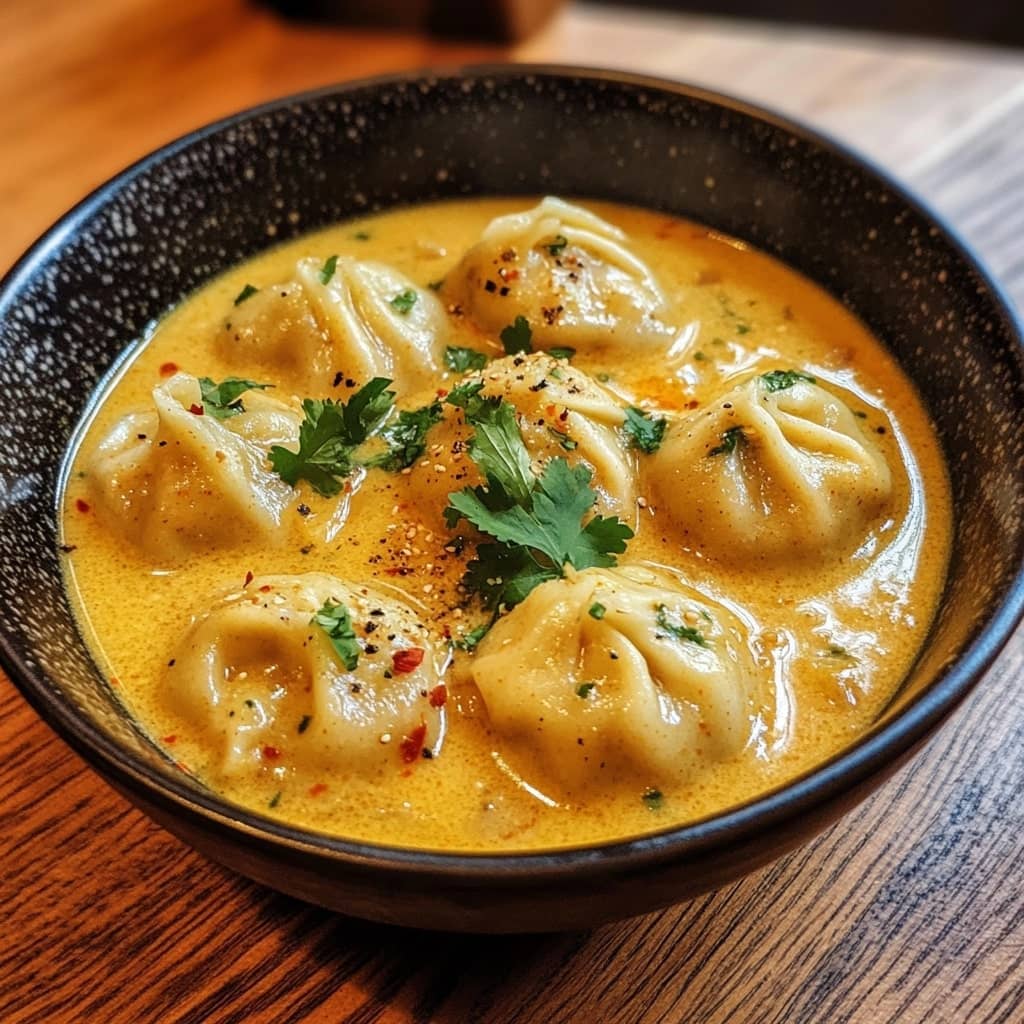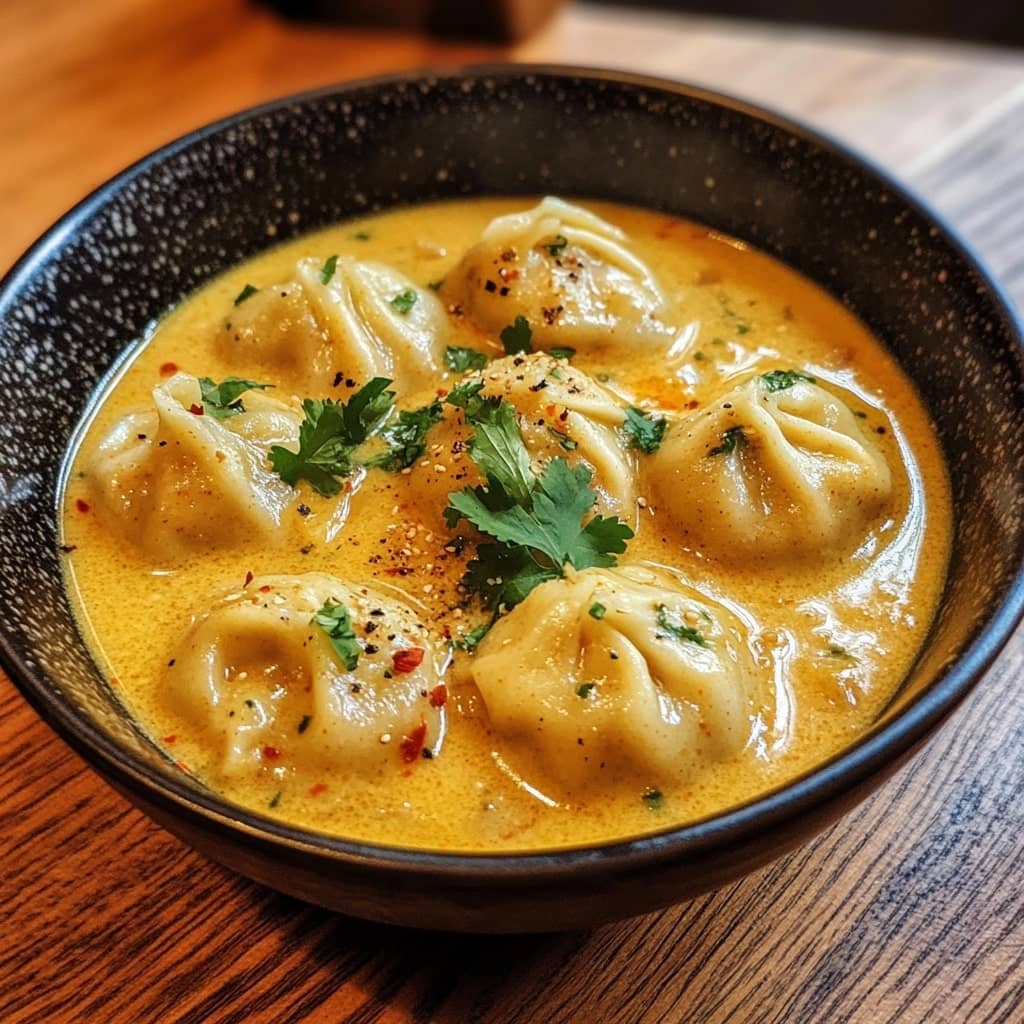Curry dumpling soup is a heartwarming, flavor-packed dish that brings together the comforting warmth of soup, the rich spices of curry, and the satisfying bite of dumplings all in one bowl. This fusion of textures and tastes makes it an ideal meal for chilly days, a cozy weeknight dinner, or a unique addition to a dinner party menu. The creamy curry broth is aromatic and bold, often made with coconut milk and a blend of spices that awaken the senses, while the dumplings—whether soft and pillowy or firm and chewy—soak up the flavors, creating little pockets of spiced goodness. It’s a dish that invites customization, celebrates cultural fusion, and offers nourishing comfort in every spoonful. Loved by fans of Asian, Indian, and Caribbean cuisines alike, curry dumpling soup represents a delicious intersection of culinary traditions and global flavors, sure to become a favorite for anyone who tries it.
The history of curry dumpling soup is not tied to a single origin but instead reflects a blend of cultural influences. Curry, a term used broadly to describe a mix of spices cooked into a sauce or broth, has its roots in South Asian cooking and has spread worldwide, adapted in countries like Thailand, Japan, and the Caribbean. Dumplings, meanwhile, are nearly universal—found in Chinese dim sum, Italian gnocchi, Jewish matzo balls, and African fufu. The concept of combining dumplings with a spiced broth likely emerged as cooks from different backgrounds experimented with melding traditional comfort foods into new forms. In Southeast Asian kitchens, coconut-based soups with meat-filled dumplings are common, while Caribbean cuisines often use curried stews with boiled dough balls. Modern curry dumpling soup as we know it likely gained popularity with the rise of fusion cuisine, as global flavors became more accessible and home cooks started blending familiar ingredients in inventive ways. Today, it exists in many forms, from vegan versions loaded with vegetables to rich, meaty stews with handmade dumplings.
Ingredients Breakdown: The components of curry dumpling soup can vary by recipe, but some key ingredients remain consistent. For the soup base, coconut milk provides creaminess and balances the heat of the curry. A good curry powder or paste is essential—yellow, red, or green curry pastes each lend a different flavor profile, with yellow being milder and more aromatic, while red and green offer more heat and pungency. Aromatics like garlic, ginger, and onion form the foundation of flavor, sautéed at the beginning to bring out their depth. Broth, either vegetable or chicken, serves as the liquid base and adds umami richness. For the dumplings, you can use pre-made wontons or potstickers, or make your own dough using flour, water, and salt. Fillings can include ground meat, tofu, or vegetables, and seasonings like soy sauce, sesame oil, or scallions. Optional additions like carrots, spinach, mushrooms, or peas make the soup more nutritious and texturally interesting. Herbs such as cilantro or Thai basil provide a fresh finish, while lime juice or a splash of vinegar adds brightness.
Step-by-Step Recipe: 1. Begin by heating a tablespoon of oil in a large pot over medium heat. Add finely chopped onion, garlic, and ginger, and sauté for 2–3 minutes until fragrant. 2. Stir in 2 tablespoons of curry paste or powder and cook for another minute to toast the spices. 3. Pour in one can of full-fat coconut milk and 4 cups of vegetable or chicken broth. Stir well to combine and bring to a simmer. 4. Add vegetables such as sliced carrots, mushrooms, or spinach and simmer for about 5–7 minutes until they start to soften. 5. While the soup simmers, prepare your dumplings. If using store-bought, set them aside. For homemade, mix 1½ cups of all-purpose flour with a pinch of salt and enough water to form a soft dough. Knead briefly and roll into small balls or fill with a mixture of your choice—like ground chicken, garlic, soy sauce, and green onions. 6. Drop dumplings gently into the simmering soup. Cover and cook for 10–12 minutes, until dumplings are cooked through and puffed up. 7. Taste and adjust seasoning with salt, pepper, or lime juice. 8. Ladle the soup into bowls and garnish with fresh herbs, a swirl of coconut milk, or a drizzle of chili oil for extra flavor.
Tips for the Perfect Soup: Use high-quality curry paste or make your own for a deeper flavor. Always sauté your aromatics before adding liquid—they unlock the full potential of your ingredients. Coconut milk should be added after spices have bloomed to prevent curdling and preserve its creamy texture. Don’t overcrowd the pot with dumplings, as they need space to cook evenly. For the best texture, add leafy greens like spinach or kale toward the end of cooking. Dumplings can be made in advance and frozen, so you always have them ready for a quick soup. Balancing the soup’s flavors is key: taste for saltiness, sweetness, acidity, and spice. Use a squeeze of lime, a pinch of sugar, or a dash of soy sauce as needed. If the broth is too thick, thin it with a bit of water or extra broth.
Variations and Customizations: Curry dumpling soup is incredibly versatile. For a Thai-inspired version, use red curry paste, add fish sauce, and finish with lime and Thai basil. A Japanese-style curry soup might use Japanese curry roux blocks and udon-style dumplings. Vegetarians can use tofu-based dumplings and load the soup with vegetables like bok choy, bell peppers, and zucchini. Vegans can swap coconut milk with oat or almond cream alternatives and use plant-based dumplings. Want a Caribbean spin? Use Jamaican curry powder, scotch bonnet peppers, and add yams or pumpkin to the broth. For extra protein, add shredded chicken, shrimp, or even poached eggs. You can also spice it up with chili oil, sriracha, or extra ginger. Gluten-free dumplings made from rice flour or cornstarch-based batters work well for dietary restrictions. You can also serve the soup over rice or noodles for a heartier meal.
Health Considerations and Nutritional Value: Curry dumpling soup can be a well-balanced meal depending on the ingredients used. Coconut milk is rich in healthy fats and adds creamy texture without dairy, though it is high in calories, so lighter versions can substitute with lite coconut milk or half broth. Dumplings provide carbohydrates and, depending on the filling, protein and fiber. Vegetable-rich versions offer vitamins A, C, and K, along with minerals and antioxidants. Using homemade broth reduces sodium content and boosts nutritional value. For a low-carb or diabetic-friendly version, opt for fewer dumplings and more vegetables. Vegan and gluten-free adaptations make this soup accessible to various diets. Be mindful of the salt and fat content if you’re watching your intake; consider using reduced-sodium broth and leaner dumpling fillings. Turmeric, a common ingredient in curry powder, has anti-inflammatory properties, and garlic and ginger can support digestion and immunity.
FAQ
Q: Can I use store-bought dumplings? A: Yes, frozen potstickers or wontons work well—just be sure to simmer them fully in the soup until cooked through.
Q: Is this soup spicy? A: It can be! The spice level depends on the type of curry paste or powder you use. Choose mild curry or adjust the amount for your preference.
Q: Can I make it ahead of time? A: Yes, you can make the broth and store it separately from the dumplings. Combine and heat when ready to serve to avoid soggy dumplings.
Q: How should I store leftovers? A: Store in an airtight container in the refrigerator for up to 3 days. Reheat gently on the stove; add a splash of water or broth if it thickens too much.
Q: Can I freeze this soup? A: The broth can be frozen on its own. Dumplings can be frozen separately before cooking. Avoid freezing the soup with dumplings already cooked in it, as they may become mushy.
Q: How can I thicken or thin the soup? A: To thicken, simmer uncovered to reduce. To thin, add more broth or water.
Q: Are there low-fat alternatives to coconut milk? A: Yes, you can use lite coconut milk or a mix of broth and plant-based milk like almond or oat for a lighter version.

Delicious Curry Dumpling Soup
Ingredients
Method
- Heat the oil in a 4 to 5-quart soup pot or Dutch oven over medium heat until it begins to shimmer.
- Add the diced onions and cook, stirring often, for about 5 minutes, or until they become soft and translucent.
- Stir in the Thai red curry paste, grated ginger, optional lemongrass, and minced garlic.
- Cook for 1–2 minutes, mixing well, until the mixture is fragrant and the ingredients are fully blended.
- Raise the heat to medium-high and pour in the chicken broth and coconut milk.
- Bring the mixture to a gentle boil, then reduce the heat to maintain a steady simmer.
- This helps the flavors meld together beautifully.
- Add the fish sauce and sugar to the pot, stirring to combine.
- Gently place the frozen dumplings into the simmering soup.
- Let the soup return to a low boil and cook the dumplings according to package directions—typically just a few minutes if they’re pre-cooked. If no boiling instructions are provided, follow the steaming time instead.
- Always ensure the dumplings are thoroughly heated before serving.
- Once the dumplings are cooked, turn off the heat.
- Add the chopped spinach, green onions, and cilantro to the pot.
- Let the soup sit for a minute so the spinach can wilt naturally in the hot broth.
- Squeeze in the juice from half a lime and stir well. Taste and adjust with more lime juice if desired for extra brightness.
- Ladle the hot soup into serving bowls.
- Top with your preferred garnishes such as diagonally sliced green onions, minced cilantro, chopped Thai basil, chili slices, crispy fried onions, or a drizzle of chili crisp.
- Serve immediately and enjoy the bold, comforting flavors of this Thai-style curry dumpling soup.
